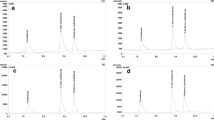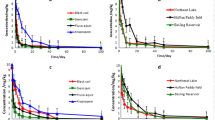Abstract
Background, aim, and scope
3-Chlorocarbazole and 3,6-dichlorocarbazole were isolated from Bavarian soils. The stereospecific formation of the isomers of these chlorinated carbazols can be explained by quantum mechanical calculations using the DFT method. It was shown that chlorination of carbazole and 3-chlorocarbazole respectively is preferred via the sigma-complexes 3-chlorocarbazole and 3,6-dichlorocarbazole as the most stable products. The dioxin-like toxicological potential of 3,6-dichlorocarbazole, determined by the Micro-EROD Test, is in the range of some picogram TCDD equivalents per milligram carbazole. The degradative fate of 3-chlorocarbazole and 3,6-dichlorocarbazole was analysed within a long-term study (57 days) in soil.
Materials and methods
The soil was extracted by ASE (accelerated solvent extraction) and a further clean-up procedure with column chromatography and chromatography with C18-SPE stationary phases. Quantification of 3-chlorocarbazole and 3,6-dichlorocarbazole was performed employing the isotope-dilution method. The samples were measured with high-resolution GC/MS.
Results
The degradation (ln(c/c0) vs. time with best-fit line) showed in almost every storage condition a very small degradation (slopes (h−1) in −10−4 range). However, the decay for the controls were two to three times (−28°C) and six times (with sodium azide) higher, than the decrease of 3-chlorocarbazole and 3,6-dichlorocarbazole in the samples of environmental conditions.
Discussion
Especially because of the toxicological potential of 3-chlorocarbazole and 3,6-dichlorocarbazole the proven degradative fate is of large interest. The results show that the analysed carbazoles are not readily degradable in this time period.
Conclusions
The expected results of exponential decay behaviour could not be proven.
Recommendation and perspectives
Longer-lasting studies are expected to reveal more accurate half-lives, although it has been shown here, that the compounds are not readily degradable in their native soil environment.


Similar content being viewed by others
Abbreviations
- A horizon:
-
Soil horizon; top soil
- ASE:
-
Accelerated solvent extraction
- Au:
-
Energy in atomic units; 1au = 627.51 kcal/mol
- B horizon:
-
Soil horizon, first horizon after top soil
- CHC:
-
Chlorinated hydrocarbons
- CIS:
-
Cold injection system
- DFT:
-
(Standard) density functional theory
- E:
-
Enthalpy [au]
- E rel :
-
Relative energy [kcal/mol]
- EI:
-
Electron ionisation
- EROD:
-
7-Ethoxyresorufin-O-deethylase
- FW:
-
Fresh weight
- GC/MS:
-
Gas chromatography and mass spectrometry
- Go-Ah:
-
24–39 cm Transfer horizon: mineral top soil horizon with accumulation of organic substances and groundwater-swayed mineral soil horizon, oxidative circumstances
- OCP:
-
Organochlorinated pesticides
- PAH:
-
Polycyclic aromatic hydrocarbons
- PCDD/F:
-
Polychlorinated dibenzo-p-dioxin and dibenzofuran
- PCT:
-
Pentachlorotoluene
- PSE:
-
Potential energy surface
- PTFE:
-
Polytetrafluoroethylene
- SIM:
-
Selective ion monitoring
- SPE:
-
Solid phase extraction
- STD:
-
Standard deviation
- TCDD:
-
2,3,7,8-Tetrachlorodibenzodioxine
- TE:
-
Toxicity equivalent
References
Ben-Daniel R, De Visser SP, Shaig S, Neumann R (2003) J Am Chem Soc 125:12116–12117
Bonesi SM, Erra-Balsells R (1997) J Heterocycl Chem 34:877–889
Bonesi SM, Ponce MA, Erra-Balsells R (2005) J Heterocycl Chem 42:867–875
Bowyer PM, Iles DH, Ledwith A (1971) J Chem So C Org 2775
Chen HJ, Hakka LE, Hinman RL, Kresge AJ, Whipple EB (1971) J Am Chem Soc 93:5102–5107
Donato MT, Gomez-Lechon MJ, Castell JV (1993) Anal Biochem 213:29–33
Foresman JB, Frisch A (1996) Exploring chemistry with electronic structure methods second edition. Gaussian Inc, Pittsburgh
Frisch MJ, Trucks GW, Schlegel HB, Scuseria GE, Robb MA, Cheeseman JR, Montgomery JA, Vreven T, Kudin KN, Burant JC, Millam JM, Iyengar SS, Tomasi J, Barone V, Mennucci B, Cossi M, Scalmani G, Rega N, Petersson GA, Nakatsuji H, Hada M, Ehara M, Toyota K, Fukuda R, Hasegawa J, Ishida M, Nakajiama T, Hona Y, Kitao K, Nakai H, Klene M, Li X, Knox JE, Hratchian HP, Cross JB, Adamo C, Jaramillo J, Gomperts R, Stratmann RE, Yazyev O, Austin AJ, Cammi R, Pompelli C, Ochterski JW, Ayala PY, Morokuma K, Voth GA, Salvador P, Dannenberg JJ, Zakrzewski VG, Dapprich S, Daniels AD, Strain MC, Farkas O, Malick DK, Rabuck AD, Raghavachari K, Foresman J, Ortiz JV, Cui Q, Baboul AG, Clifford S, Cioslowski J, Stefanov BB, Liu G, Liashenko A, Piskorz P, Komaromi I, Martin RL, Fox DJ, Keith T, Al-Laham MA, Peng CY, Nanayakkara A, Challacombe M, Gill PMW, Johnson B, Chen W, Wong MW, Gonzales C, Pople JA (2004) Gaussian 03 (Revision C.02). Gaussian, Inc, Wallingford
Gribble GW (1998) Acc Chem Res 31:141–152
Gribble GW (2003) Chemosphere 52:289–297
Gribble W (2004) ‘Natural organohalogens’ science dossier euro chlor. Dartmouth College, Hanover, New Hampshire
Kronimus A, Schwarzbauer J, Dsikowitzky L, Heim S, Littke R (2004) Water Res 38:3473–3484
Moskalev NV, Sirotkina EE, Ogorodnikov VD (1985) Chem Heterocycl Compd 21(5):542–543
Ohashi M, Tsujimoto K, Yonezawa T (1970a) J Chem Soc. D Chem Commun 1089-1099
Ohashi M, Tsujimoto K, Yoshino A, Yonezawa T (1970b) Org Mass Spectrom 4:203–210
Plant SGP, Powell J F (1947) J Chem Soc 937–939
Reischl A, Joneck M, Dumler-Gradl R (2005) UWSF-Z- Umweltchem Ökotox 17:197–200
Schwirzer SMG, Hofmaier AM, Kettrup A, Nerdinger PE, Schramm K-W, Thoma H, Wegenke M, Wiebel FJ (1998) Ecotoxicol Environ Saf 41:77–82
Shekhirev YP, Lopatinskii VP, Sutyagin VM, Tuzovskaya SA (1983) Chem Heterocycl Compd 19(11):1192–1197
Smith MB, March J (2006) Advanced organic chemistry, reactions, mechanisms, and structure, 6th edn. Wiley, New York
Takasuga T, Takemori H, Yamamoto T, Higashino K, Sasaki Y, Weber R (2009) Organohalogen Compd 71:2239
Taylor R (1990) Electrophilic aromatic substitution. Wiley, New York
Tröbs L (2009) ‘The degradative fate of 3,6-dichlorocarbazole in soils’, Bachelor Thesis, Institut für Ökologische Chemie des Helmholtz Zentrum München, Lehrstuhl für Analytische Chemie der Technischen Universität München – Department Chemie – Institut für Wasserchemie und Chemische Balneologie
Tsujimoto K, Ohashi M, Yonezawa T (1972) Bull Chem Soc Jpn 45:515–519
Wang J, Bi Y, Pfister G, Henkelmann B, Zhu K, Schramm K-W (2009) Chemosphere 75:1119–1127
Author information
Authors and Affiliations
Corresponding author
Additional information
Responsible editor: Ake Bergman
This publication is dedicated to Prof. Sandermann on the occasion of his death on August 18th, 2009.
Rights and permissions
About this article
Cite this article
Tröbs, L., Henkelmann, B., Lenoir, D. et al. Degradative fate of 3-chlorocarbazole and 3,6-dichlorocarbazole in soil. Environ Sci Pollut Res 18, 547–555 (2011). https://doi.org/10.1007/s11356-010-0393-0
Received:
Accepted:
Published:
Issue Date:
DOI: https://doi.org/10.1007/s11356-010-0393-0




